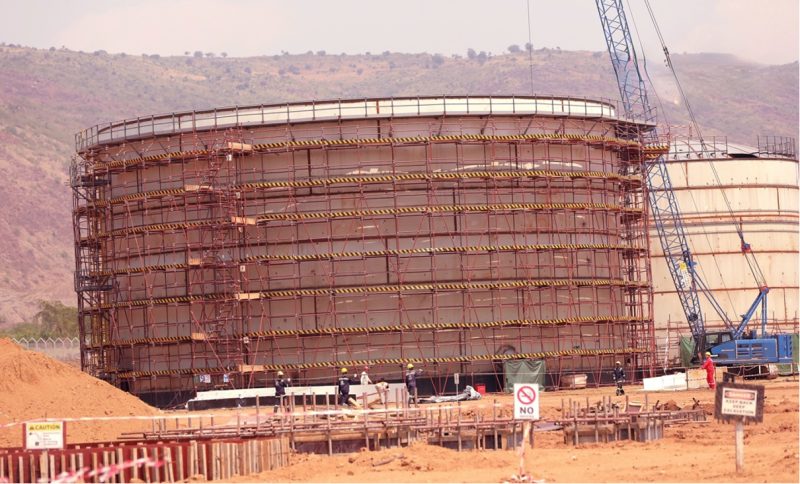Uganda is on track to deliver first oil from its Lake Albert development by 2025 after having so far drilled 63 of the 426 wells planned at TotalEnergie’s Tilenga side of the project and nine out of the 11 wells required for first oil at Chinese major CNOOC’s Kingfisher project.
TotalEnergies’ 63 wells at Tilenga exceed the number needed for first oil, Uganda’s Minister for Energy and Mineral Development, Ruth Nankabirwa Ssentamu, told a press briefing in Kampala on 21 August.
TotalEnergies E&P Uganda, CNOOC Uganda Ltd, and the Uganda National Oil Company (UNOC) are developing the $6-billion upstream Tilenga and Kingfisher projects which together with the East African Crude Oil Pipeline (EACOP) ($5 billion) and the Uganda Refinery project ($4 billion) represent a combined investment of approximately $20 billion into Uganda's economy.
In her project update Nankabirwa noted that
- Civil works are expected to be fully operational in time for first oil with the Tilenga Industrial Area 99.7% complete and the ongoing construction of the Central Processing Facility (CPF) proceeding as planned.
- Land acquisition is nearly complete for all major projects including Tilenga, Kingfisher, and the EACOP.
- $2 billion worth of contracts have been awarded to Ugandan companies, showcasing a strong local content component.

“Our integrated approach, which includes the upstream, midstream, and downstream sectors, positions Uganda to significantly contribute to the global oil supply, fostering economic growth and boosting national revenue” while maintaining a balance between economic growth, social development and environmental conservation, Nankabirwa told reporters.
The minister noted that Uganda’s estimated 6.5 billion bbl of reserves (of which 1.5 billion bbl are deemed as recoverable) “are not only pivotal for Uganda's economy but also have significant implications for the global energy market … contributing to global energy security.”
To add to those reserves, thus extending the life of the development’s midstream projects, exploration licenses were granted in February and May 2023 to UNOC and DGR Energy Turaco Uganda SMC Ltd. for the Kasuruban and Turaco contract areas, respectively.
More Exploration in the Works
Oranto Petroleum Ltd. and Armour Energy Uganda Ltd. have held licenses since 2017 for the Ngassa Deep & Shallow Play and the Kanywataba contract areas but continue technical studies and have yet to drill, according to the ministry’s update.
Uganda is a landlocked country with no current hydrocarbon production. Exploration and development is centered in the Albert-Edward Rift Basin, a part of the East African Rift system which lies in northwest Uganda and extends into the Democratic Republic of Congo.
The scarcity of exploration wells, combined with poor-quality seismic data, has made it problematic to assess reservoir potential in the area, as described in a paper presented in March 2019 at the International Petroleum Technology Conference (IPTC) by CNOOC’s Research Institute in Beijing.
Since 2006, however, 1.5 billion bbl of recoverable reserves have been discovered in Blocks 1 and 2 of the Tilenga field and Block 3A of Kingfisher.
At peak plateau, upstream partners—TotalEnergies (56.67%), CNOOC (28.33%), and UNOC (15%)—expect to produce 230,000 B/D basinwide to satisfy domestic needs and for export via the EACOP to Tanzania’s port of Tanga on the Indian Ocean coast.
As for the midstream and downstream components, Nankabirwa told reporters:
- Worley is progressing with its execution of the engineering, procurement, construction management, and commissioning contract related to the EACOP, with civil works at the main camps and pipe yards progressing steadily. Seven batches of line pipes, totaling 500 km, have been delivered to Tanzania.
- Negotiations are ongoing with the UAE’s Alpha MBM Investments LLC for key commercial agreements related to the development of the Uganda refinery which will supply the country’s domestic petroleum needs as well as demand of the greater East African Community.
- UNOC is taking steps to secure domestic supply having recently signed a supply agreement with Vitol Bahrain and obtained a petroleum license from the Energy and Petroleum Regulatory Authority in Kenya.
TotalEnergies holds a 62% share in EACOP with UNOC (15%), Tanzania Petroleum Development Corporation (15%), and CNOOC (8%).
FOR FURTHER READING
IPTC 19372 Stratigraphic Forward Simulation of the Miocene Fan Delta in the South of Albert Basin, Uganda by Wei Xu, Yingchun Zhang, Lei Fang, et al., CNOOC Research Institute Co. Ltd.


